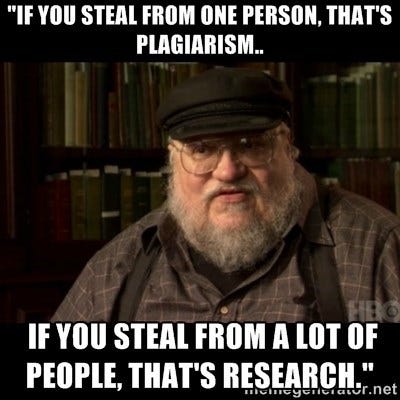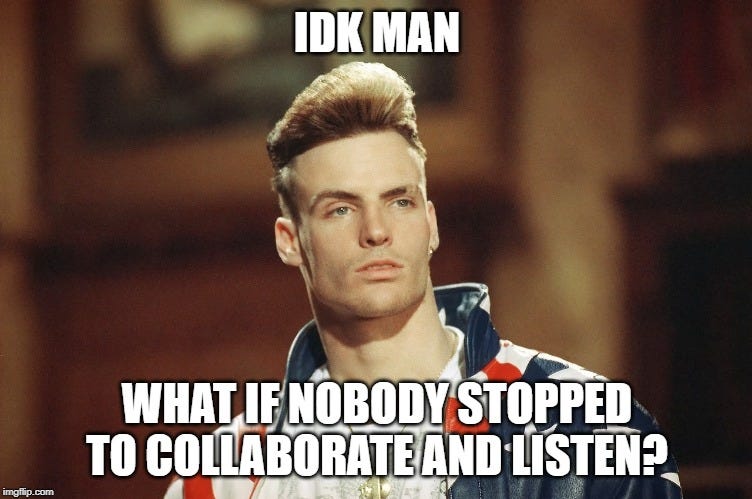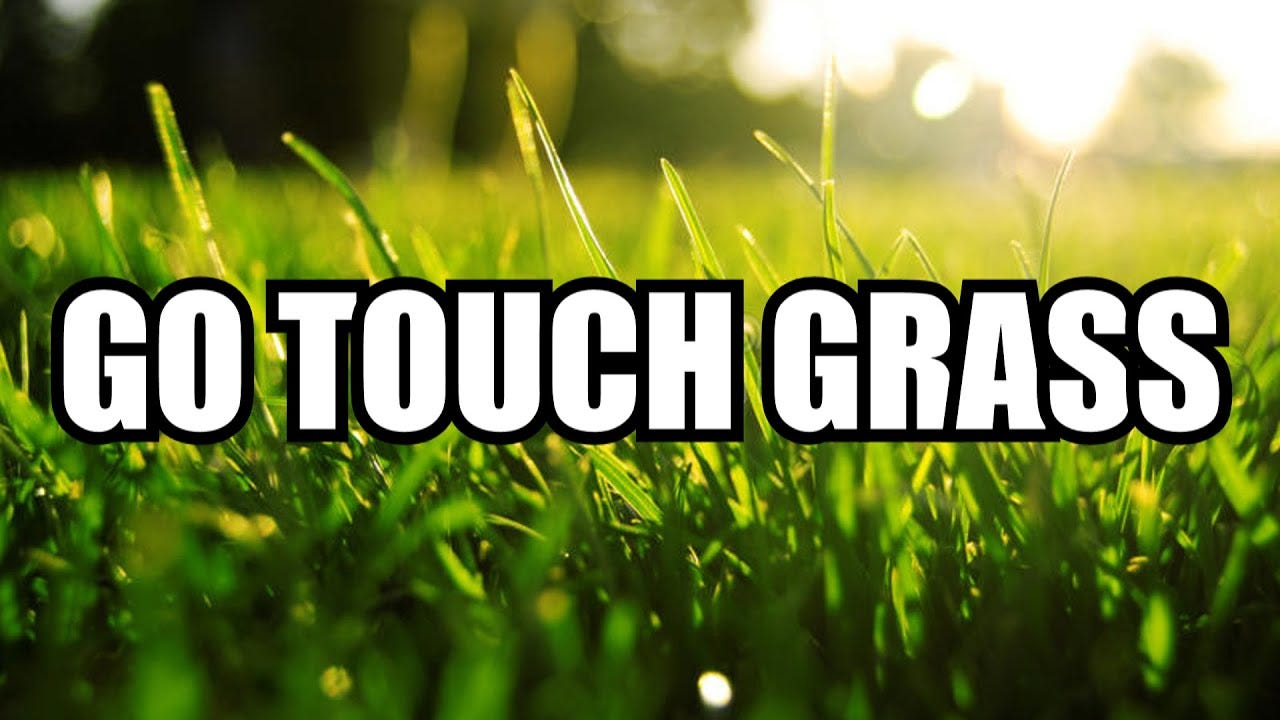Plagiarism and the Performance of Credibility
When Internet Drama Feels Too Scripted to Be Fake
🎤 “Let’s get ready to RUMBLE!”
Okay, that was my best Michael Buffer impersonation. I’m not sure if I hit the mark, but let’s go with it… Cue the spotlight and several thousand stunned Substack subscribers fumbling for their popcorn…
In this corner: Katie Jgln – a self-proclaimed writer, researcher, and social scientist, with the title of “Internet Personality” bestowed by Google. Known for her sharp observations and a growing Substack readership. She’s got notes, timestamps, and a righteous fury burning with the fire of a thousand properly cited footnotes.
And in the opposing corner: maalvika – a PhD student at Northwestern University, ironically “interested in examining how big data and algorithms are creating and exacerbating disparities in infrastructure, systems, and social networks, to eventually help in reducing them.” She arrives with a history of thoughtful reflections on algorithmic culture, a TikTok following, and until recently, a public-facing Squarespace site.
The issue?
Plagiarism. Alleged and then admitted.
The stakes?
Intellectual credibility in an age of AI ambiguity.
The prize?
Trust, virality, and the moral high ground (if anyone can still find it).
And this isn’t your average internet squabble. No passive-aggressive subtweets. No vaguely worded Medium essays. This was/is a full-blown public showdown, unfolding in real time across posts, notes, screenshots, and comments, with many of my favorite memes…
And all of it was eerily reminiscent of the early 2000s feud between another set of young girls: Paris Hilton and Nicole Richie – that is if Paris had cited Pew Research and Nicole had responded with citation forensics.
Just in case you’ve been offline the past few days and completely missed this viral exchange, grab your popcorn.
Here’s how it started:
The gauntlet was dropped on July 27, when Katie published a sharply worded Substack note, accusing Maalvika of copying her February 9, 2024 article Why Social Media Algorithms Are Behind So Much of What We See Online. She didn’t mince words:
“Full-on copy-paste with a few synonyms thrown in.”
“Shameless.”
“This is hardly the haven of thoughtful, original work some people pretend it is.”
The next day, she followed up with a detailed, widely shared post titled Mama, There’s a Plagiarist Behind You, documenting her claims with side-by-side screenshots. The article quickly shot to the top of the Substack trending feed.
On July 29, Maalvika responded with a public apology (strangely posted as a screenshot of text). She admitted to using Katie’s words without proper credit in a March, 2024 piece that she authored. Then she called it an “editing oversight,” claimed her intent had been to engage in dialogue, and then stated that she had included Katie’s name citing her elsewhere in the same essay. She included a screenshot of the article as “proof” of her citation. She emphasized that she took the post down immediately when Katie reached out – back in March 2024 – and thought the issue was resolved.
Accused. Apologized. End of story? Not even close.
Katie replied with forensic detail: the Pew Research statistics Maalvika cited in her apology? They were from December 2024 – nine months after the plagiarized article had been published and removed. Unless Maalvika was somehow time-traveling through algorithmic wormholes, there was no way those stats could have been referenced in her March post. Katie linked directly to the December 12, 2024 Pew study to “prove” it.
Then came an anonymous user, Spring (a.k.a. springblossoms): a Substack user with no posts, 2 subscribers, and a timeline full of Maalvika likes swooped in to defend her, citing an earlier Pew study from March 11, 2024 as “proof” that the stats existed two days before Maalvika’s article in question.
Ha! Counter-punch! Case closed…? Not quite.
Katie – and a few eagle-eyed commenters – quickly pointed out that the March Pew study didn’t contain the same statistics Maalvika referenced, specifically around the specific demographic and YouTube usage numbers that are an exact match for the December study. You can either take my word for it or verify it yourself here and here.
Ouch! So, not only did Maalvika claim this to be nothing more than an “editing oversight” in her "apology” (missing the point that to start a draft by editing someone else’s work is plagiarism, or plagiarism-questionable at best), she also seemed to double down on a second falsehood that she had cited Katie in an article that couldn’t have existed until months later.
Ooo! Ouch! Point for Katie in this round.
Meanwhile, Maalvika’s website quietly went offline, now displaying a plain-text Squarespace message: “Private Site.” And while she hasn’t said anything publicly since the apology, the algorithm has spoken: Maalvika’s Substack subscriber count dropped from ~38K to just under ~32K, while Katie’s rose from under 10K to nearly 13K in three days.
It was (or still is), by all measures, quite the spectacle.
Which brings us to here – to you, to me, to a screen glowing back at us as we scroll through comment threads and restack counts and think: What are we even watching? Why can’t we look away? And when everything feels so staged, performative, and algorithmically juiced – what counts as real anymore at all?
I don’t even like reality TV, so why am I so drawn in?
I’ve rolled my eyes at every friend that even mentioned the Bachelor. I never followed the early 2000s drama of Paris and Nicole. Manufactured drama, performative emotion, algorithmic conflict? Meh. Hard pass. Give me a long walk, a good book, or an awkward dinner party over the spectacle of people unraveling for clicks.
And yet, here I am – four days deep into a plagiarism feud between two Substack writers I’ve never met, toggling between screenshots, reading Pew Research articles, checking comment timelines, and refreshing their subscriber counts like any of it matters.
I’ve read their essays. I’ve watched their Tiky-Tocks. I’ve followed the breadcrumb trail of springblossoms and compared demographic charts from March and December. Somewhere along the way, I even Googled historical pages of each of them for clues, as if I were on some kind of journalistic scavenger hunt.
Why?
Why am I so pulled in by this?
Part of it, I think, is the subject matter. This isn’t about celebrity gossip or another micro-scandal lost in the churn. It’s about something deeper: authorship, credibility, and trust. The ethics of voice and ownership in a world where AI, algorithms, and acceleration are bending those very terms out of shape.
When someone yells “plagiarism” online, it’s not just a claim. It’s a flare gun fired into a sky already filled with doubt. We don’t just want to know who stole what – we have a strange craving to see “justice.” Some obscurely righteous part of us seeks retribution. We want to know that words still matter, and that authorship still means something.
And when that line gets blurred – not just by AI, but by real humans with complex motivations, real talents, and real blind spots – the whole thing becomes messier, and more emotionally charged.
It’s tempting to watch like a spectator. But the more I stare, the more I recognize myself – and maybe that’s the uncomfortable part. Because I write too. I care about ideas, integrity, and the shape of a sentence. I pay attention to what I write, and it’s important that it feels like my own.
And yet…
How much of what I write is truly “mine?” How often do I paraphrase something I once heard but no longer remember where from? How many of my insights are shaped by the hundreds of podcasts, essays, or voices I absorbed without clear-cut citation? Admittedly, I use AI to brainstorm ideas, reconsider my thoughts, and clarify my often messy stream of consciousness into something coherent. Does that disqualify me from sharing authentically? I don’t think so, but some would argue otherwise.
The truth is, this feud doesn’t feel like just Katie and Maalvika on the stage. It’s all of us. Watching. Writing. Scrolling. Commenting. Quoting. Paraphrasing. Trying to find our place in a digital ecosystem where ownership is slippery, algorithms reward speed over process, and trust – real trust – is hard, if not impossible, to come by.
So maybe I’m not here because of the drama. Maybe I’m here because, underneath the spectacle, this is circling a topic that matters deeply. We need to ask ourselves: what kind of world are we releasing our ideas into and how do we do it responsibly when the lines are getting blurrier by the day.
How do we even know what’s real?
Let me be clear: calling this “reality TV” isn’t an accusation. I don’t think this was faked, scripted, or manufactured in some cynical attempt to go viral. I believe Katie and Maalvika are real people, with real histories, and real emotional stakes in this very public unraveling. I mean, if these two individuals were just completely fabricated AI personalities (as some commenters are claiming) it’s an impressive backstory that goes back more than a decade.
But the structure of it all – the dramatic arc, the plot reversals, the sudden rise and fall of follower counts – feels so eerily produced, I can’t help but wonder...
What if something like this had been staged?
Let’s play it out: in a hypothetical world where I wanted to create an online media moment, it would need to be something sticky, emotional, and perfectly platform-ready. I wouldn’t need to invent much. And in a world of deep fakes it wouldn’t be that hard. The formula already exists. I’d just need to follow it.
The key ingredient: Conflict. Everybody loves a good conflict. But not just any conflict. It needs to be something that resonates morally. Something that feels personal and philosophical. Something that allows readers to take sides and feel righteous about it.
What’s the right topic? Let’s hit some trending hot-button: oh… duh, AI! But not AI directly. That’s too broad. And it’s too abstract. We need something more visceral. Something that hits close to the creative bone. Ah: plagiarism! Yes! Now that’s got teeth. The theft of ideas. The corruption of authorship. The betrayal of trust. It’s perfect.
Now, who should be the villain and who should be the victim?
Maybe a teenage TikToker plagiarizing a tenured professor? Hmmmmm… That might backfire. People still instinctively side with authority. Okay, flip it. The professor plagiarizes the teenager. That’s juicy and unexpected. But that would be hard to pull off convincingly unless we build a whole backstory, and tenured professors are difficult to fake convincingly online. Too many faculty pages. Too many PDFs.
No, what we need are relatable intellectuals. People on the rise. Smart, but not too established. Public, but not too famous. That sweet spot where they’re aspirational, not untouchable.
Let’s cast a social science PhD student. Yeah, that’s it! Let’s make it super ironic… someone who writes about the ethics of digital systems. Yes! Now let’s pair her with a cultural writer… someone exploring gender, power, and the subtle politics of online life. Oh, this is getting good. Give them both a solid TikTok presence. A few moody videos. Some deadpan delivery. Aesthetics that say “former indie film minor turned systems theorist.” Oh! And let them be young, conventionally attractive, media-savvy... the kind of people who once posted dance videos in 2019 and now talk about digital ethics over lo-fi background tracks.
Now we’ve got something. Two writers. Both brilliant. Both photogenic. Both a little bit niche. One accuses. One apologizes. Throw in a deleted article, a time-traveling Pew statistic, a mystery account named springblossoms, and a disappearing Squarespace site, and…
Well… honestly? I couldn’t have cast this feud better if I tried.
But the real casualty is trust
The thing is, even if this feud isn’t staged – and again, I don’t believe it is – the fact that it feels like it could be is already a kind of loss. It’s a loss of grounding, of shared reality, and most of all, a loss of trust.
Because if two articulate, visible, seemingly authentic writers can be pulled into a plagiarism spiral – complete with screenshots, counter-screenshots, anonymous defenders, and citation forensics – and we’re still left wondering who to believe… then what hope do we have in the rest of our digital life? How do we tell what’s real, what’s derived, and what’s just been repackaged with polish?
We used to trust by proximity: I know this person. I’ve worked with them. I’ve heard them think in real time. Now we trust by projection: This post sounds sincere. This essay feels intelligent. This video hits the right cadence of vulnerability. Or most often, we use follower count as a proxy for credibility. Oops!
We’ve substituted the experience of someone’s presence with the performance of credibility. And the algorithms are perfectly happy with that – because performance is easier to reward. Let’s be honest: the algorithm doesn’t care who’s telling the truth. It only cares who’s generating engagement. It rewards drama, not diligence. Outrage sells where nuance more often falls flat. The algorithms have learned what triggers us humans. We – and thus it – thrives on moral conflict, so long as it’s clickable.
And the worst part? Most of these systems weren’t even designed for deception. They were just built without accountability in mind. We trained them to prioritize attention, and they’ve gotten very, very good at delivering it – even if the cost is our ability to discern what’s genuine.
We’ve built a house where everyone talks and very few genuinely listen. It didn’t start with this feud, but it does make something painfully clear: we need better ways to signal trust online.
We’ve attempted this before. In the early days of eBay, reputation systems were everything. You didn’t buy from someone with no feedback. Trust was built through transparency, through record, through time. But when it came to social media, we replaced reputation with reach as its proxy. And now here we are – measuring integrity by follower counts and aesthetics.
And the deeper problem? We’ve convinced ourselves it doesn’t matter. “It’s just online,” we say. “At least it’s not IRL.”
But it is.
Watch The Antisocial Network, and you’ll see what happens when online distrust metastasizes. The film traces the trajectory from 2chan to 4chan to Anonymous to QAnon. It’s so easy to go from meme culture to movements that fueled real-world political mayhem. It’s not fiction. It’s not satire. It’s the story of how ironic detachment turned into unhinged belief – and how a generation raised on message boards ended up in riot gear.
What starts as performance doesn’t always stay there. What feels like spectacle can so easily transform into ideology. And what happens online rarely ever stays online.
Which leads us to a question that no comment section has fully answered: Where do we draw the line? When does interpretation become plagiarism? Is it okay to remix someone else’s “rhythm” as long as you swap out the words? Is it plagiarism if you’ve internalized multiple sources of ideas and written related ideas?
It’s just as difficult to do this in writing as it is in music. We celebrate “influence” and condemn “theft.” Famous jazz legend Herbie Hancock famously said:
“That’s how I learned: from people who are older than me. I felt like I stood on the shoulders of giants and now it’s my turn.”
John Coltrane is another example. He didn’t hide the voices he studied – he transformed them. He synthesized his lineage into something unmistakably his.
And yet, when we hear a tune from Robert Matthew Van Winkle (a.k.a. Vanilla Ice) that sounds so eerily familiar to any fan of Queen or David Bowie, we cringe. He changed one note! One note! And then he insists it was original!? But that’s all it took for us to see the line: one note.
So where do we place Maalvika on this spectrum?
What she did seemed less like original authorship and much more like rearranging someone else’s thoughts to barely pass as her own. The example Katie presented was blatant – so much so that we respond almost instantly, and almost unanimously, in condemnation. And perhaps rightfully so. Admittedly, I was one of the shaming voices in the comments.
But the more I think about it, the more I wonder: how different is what she did from what many of us do – just more slowly, more carefully, with more layers of synthesis and time?
So, it’s not just the act of transforming content. It’s the pace. The depth. The process.
There’s a difference between copying and revising something to appear original – and spending months absorbing books, podcasts, essays, and conversations, letting them compost and ferment and eventually emerge as something that might still be influenced, but undeniably yours.
That doesn’t mean everything we write is fully “ours.” It never was. All of us stand on the shoulders of giants that came before us. But in today’s fast-paced, AI-assisted world, we’ve skipped over the process and gone straight to the performance. We want to own the idea. We want to be seen as the source. We have turned into Gollum with his “precious” – clinging to originality not because it’s true, but because it feels like power.
And until we slow down enough to know the difference – between what moved through us and what we moved through – we’ll keep confusing sounding smart with being sincere.
So maybe the real problem is simply that we’re all operating inside a system that thrives on ambiguity – while pretending to be about truth. And if we can’t find a new system – one that values presence over performance – then maybe the most responsible thing we can do is…
Go touch grass!
As the famous meme reminds us, maybe it’s time to close the tab and step outside. Maybe it’s time to step away from the drama, the comments, the threads, the algorithmic rabbit holes that feel like they matter. Stay outside until you remember the texture of bark or the sound of your own breath in a quiet field. Maybe the most radical act isn’t to pick a side or post a long article about touching grass (like this hypocritical author) – maybe it’s simply to step outside. Touch the earth. Make eye contact with someone who isn’t performing for a screen.
There’s a clarity that comes when you rejoin the physical world. It reminds us that trust begins with presence. And maybe that’s what we’re all starving for – not better content, but better contact. The kind that can’t be faked. The kind that doesn't rely on citations, performance, or clout. Just reality. Messy, slow, unscripted reality.
But reconnecting with “real life” alone won’t fix this. If we want to keep creating, sharing, participating in public life – and I do – then we need new systems too. Not ones that reward spectacle by default, but ones that recognize the value of thoughtfulness and transparency. We need reputational signals that don’t just reflect popularity or aesthetics, but context – something closer to how trust works in real life: gradually, relationally, and shaped by what we’ve shown over time, not just how effective we may have grown a following.
Otherwise, the game stays the same. And the casualties pile up. So yes – touch grass. Then, if it still makes sense, come back with a little more patience and perspective. A little more resistance. A little more reverence for the work, and the world, and the people behind it. Because how we choose to create – and how we choose to trust – is shaping more than just what shows up in our feeds. It’s shaping the future of what we believe is real.














I enjoyed reading this, you are a very animated and entertaining writer. And to answer your comment on my post, I do agree with you and I think multiple things are true at once. I agree, the lines are getting blurred, as Americans (please be American lol) we are obsessed with "justice" for sociopolitical reasons.
I actually have a theory that social media websites will only take off if there's two things: conflict with a clear winner and loser that an overwhelming majority of the website can agree upon and if a meme can start on that site and travel elsewhere. So I think your analysis part of why the debacle is addicting and drawn out. I like your definition and explanation of performance, definitely something to think about.
Glenn -- lots to think about. I think in the issue at hand is the difference between Coltrane referencing his influences vs. If Coltrane pressed play on a recording of his influences and claimed that he wrote and performed it. Musicians get successfully sued for leaning too much on it - hip hop changed after it happened to Biz Markie, I believe Nick Cave's Grinderman lost a suit. I think these things tend to escalate not just when it happens, but when somebody wins with it, as had Maalvika.
The redux of Dada in online culture has been positing a philosophically problematic idea that no effort is the same as maximum effort. The laziest or most disconnected aesthetic plays with an audience who faces the broader conflict you're examining -- how can we declare that something commanding our time, ambition, effort, and agtention with total centrality to "not matter?" We need to decide, individually, what does or doesn't hold meaning for us, and then hold ourselves to those standards, and that proves nearly impossible without other participants to quit the program.
Especially in the arts, where unless you aim to languish in obscurity (which begs the question of why make anything and speaks to the non-point of neo Dada), you need these metrics to book shows, to get dealers or gallerists to look at you, to present a publisher with a prospect of readership. I don't think most people are strong enough to walk on their own or have the resources to facilitate a place or events that could help.